You think it might be stieff rose... but is it?


You think it might be stieff rose... but is it?


Over the years there have been a lot of “look alike” Sterling Silver items on the market trying to look like what is commonly called the “Baltimore Roses” The “Baltimore Roses” are Kirk’s Repoussé, Stieff Rose and Schofield’s Baltimore Rose pattern. Below are examples of each of the patterns... and then examples of other companies examples of floral or rose patterns that people confuse as Stieff Rose.
S. KIRK & SON
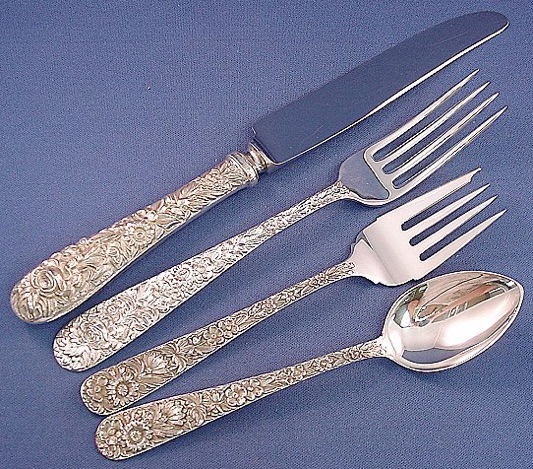
This shows several generations of the Kirk Repoussé pattern
The top two pieces being newer... the spoon is slightly different from the salad fork.
The pattern originated in 1846 (not 1828, that was the HOLLOW WARE of the same name) Notice that later versions of the KIRK pattern morphed from the daisy/chrysanthemum into the large central rose. These later pieces really confuse a lot of people as they think it is either KIRK ROSE (see below) or that they have the pattern Stieff Rose. Also, most KIRK knives are NOT hand chased on the sides. Some older round handle versions are fully chased.
A confusion of the Rose name
In 1937 Kirk introduced a pattern called ROSE. While most do not confuse the two... the problem arrises when people use the name KIRK STIEFF to describe anything that was made by one or the other company. Below is an example of Kirk’s Rose pattern of 1937. Using the KIRK STIEFF name just confuses people. If it is STIEFF, call it STIEFF, IF it was made by KIRK, use that name.

“ROSE”
The 1937 pattern by S. Kirk and Son
A confusion occurs when people refer to Stieff or Kirk silver as KIRK STIEFF, and call the above pattern KIRK STIEFF ROSE
The Stieff Company bought Kirk in 1979 creating The Kirk Stieff Company
The Kirk Stieff Company kept the names stamped on the backs of the established patterns separate. The Stieff patterns got the Stieff name and Kirks patterns the Kirk name. ONLY on patterns introduced after 1980 did the KIRK STIEFF name appear... with the exception of KNIVES. The two brands started sharing knife blades so all patterns started using Kirk-Stieff branded blades. Only new patterns created by Kirk Stieff after 1980 should be called Kirk Stieff by brand name.
Schofield Silver
Some people confuse Stieff ROSE with the Stieff pattern PRINCESS
Sometimes called Hand Chased Rose
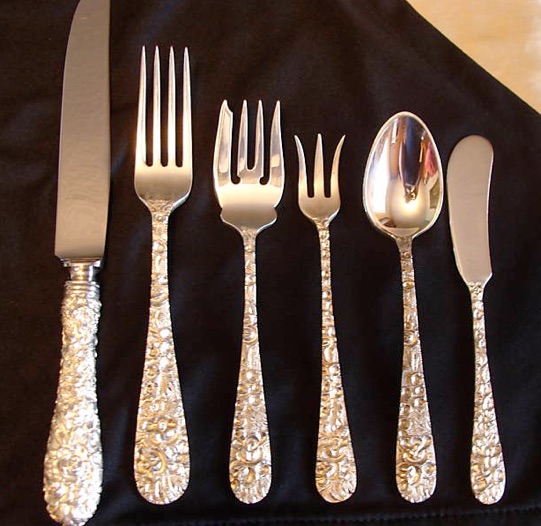
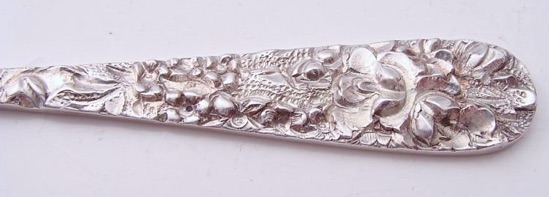

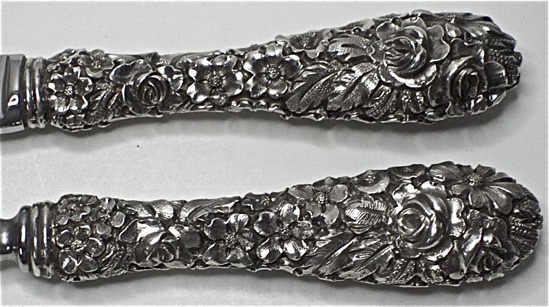
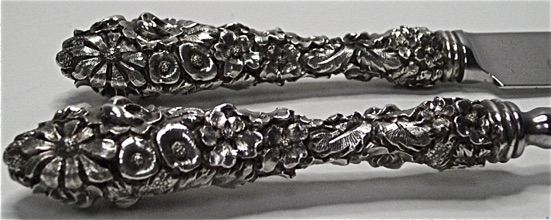
Princess is HAND CHASED. While it is very similar to the ROSE pattern, this is basically hand carved in very deep relief. While Rose was struck with dies, Princess required hours of hand work by a master silversmith to create. Normally Princess sold for 3-4 times the price of Stieff Rose. The vast majority of the time, Princess is marked HAND CHASED, although I do see a few pieces from time to time that are not marked as such. The weight of Princess is also notably heavier than Rose.
Spoons and forks in the Stieff Rose pattern have a slight lift at the tip of the handle.
The Princess pattern lays flat with no lift.
More on the Princess pattern in the Stieff Patterns section of this site.
Jenkins and Jenkins aka Jacobi & Jenkins
Another wonderful Baltimore silver company that would eventually be bought by Schofield was Jenkins & Jenkins. Their pattern called Repoussé was one of those that inspired Stieff Rose.

Again, it is on ebay that I see this most often called Stieff Rose. Of course the back has the makers name.. so I can only assume some people have been in business so long that they do not question their own ability to determine patterns... or they are just stupid.
National Silver Company’s
Narcissus pattern

Narcissus was also made in silver plated wares
Humphrey’s Silver
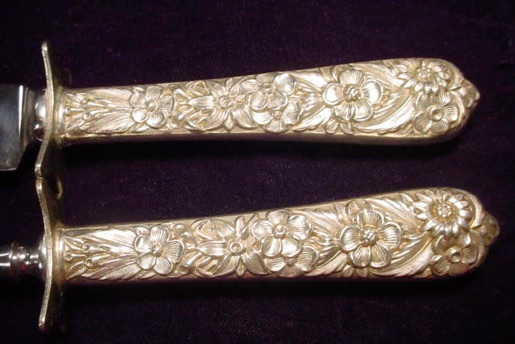
To me this looks like a dead ringer for International Silver’s Radiant Rose.
The sides of the handles are un-chased.
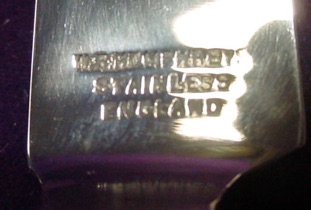
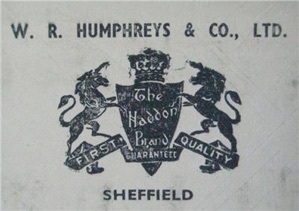

The pattern ARLINGTON by Towle Silver. The pattern is very flat, and I do not understand how people confuse this with Stieff Rose
And then there is the “Channel Back” issue
Click on the photo above to learn about Channel Back. There is a history of KLANK silver here and the story that is woven around this pattern and Klank, Stieff and Schofield.
This pattern also looks a lot like the Schofield pattern Baltimore Rose.
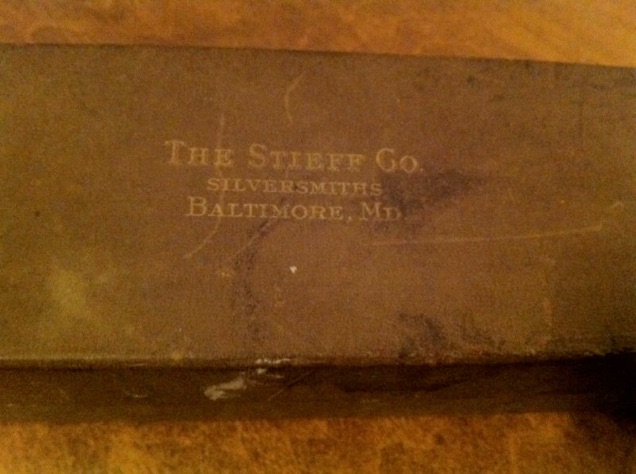
Imprint on a 1930’s Stieff Company box
If you are in doubt if your pattern is Stieff, you can email me a photo and I would be glad to help.
Scottinelmgrove@yahoo.com
ALVIN
The 1932 Alvin Silver pattern Bridal Bouquet is also a confusion for many. Alvin is/was located in Providence RI, and is part of Gorham Silver Co.
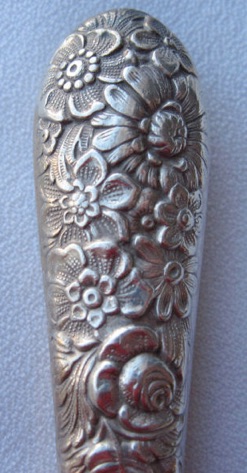
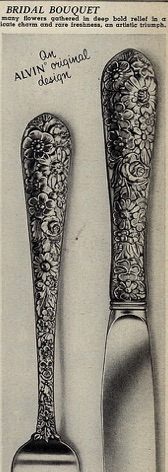


Not all Alvin silver is as clearly marked as this piece. Some are just marked STERLING, which could be a result of Alvin doing a bit of what we now call “private label” work. The silver would be sold to small chains that wanted their own brand.. and would stamp their name on the silver. Sometimes, the stamping did not happen and pieces slipped to the public with out the stores name stamped on it. This pattern also looks a lot like Manchester silver’s Southern Rose.
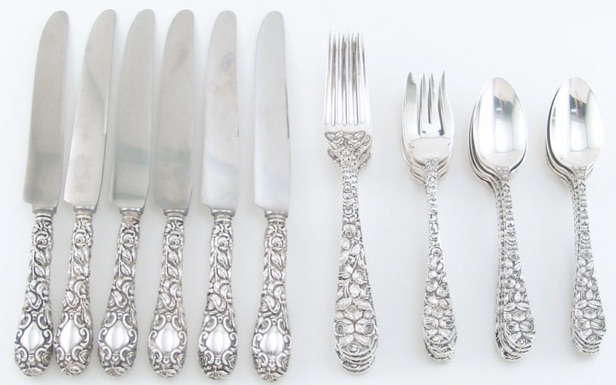
Schofield’s Baltimore Rose

Upper pattern is dominated by a cluster of 3 Roses with trailing vines
Originating in 1903, this pattern was made until 1977, 10 years after Stieff bought Schofield.
Most pieces of this pattern are double sided with the design on both sides, but some were made one sided.
Some people lump the products of STIEFF, KIRK, JENKINS and SCHOFIELD under the umbrella name of BALTIMORE ROSE or the BALTIMORE ROSE’S. While it does identify a regional style of silver, it also creates the image in some minds that the silver is alike. If people referred to automobiles as the DETROIT CARS... it would be confusing, as they are very different... but for some reason some people do not mind clumping certain Baltimore silver patterns together under one name.
More on Schofield Silver in the Schofield section on this site
Stieff Rose morphed over the years, so the pattern did not keep the same look over the decades.
More on these changes at the Date marks and year differences section on this site.

Stieff Rose showing several generations of handles.
The Rose pattern morphed over the years. Learn more about the subtle changes at:
Date Marks and Year Differences
Post June 1904 Stieff Silver is always marked STIEFF. This is either on the blade of the knife, and on older knifes, also on the handle. Forks and spoons and other pieces will have the name on the back of the handle. Early pieces will be marked with the Crown B for Baltimore Sterling Silver Co. which was the name of the company prior to June 1904.
There are some Balt. Sterling Silver Co. pieces not marked STIEFF, that were made for retailers looking to use their own name on the silver. This is limited to the Rose and Chrysanthemum patterns. You do not find these very often. If you think you have some... please feel free to email me a photo or two and I can confirm this rare pieces for you.
Also from Jacobi & Jenkins these salt spoons.
Prior to Jenkins & Jenkins, it was called Jocobi & Jenkins
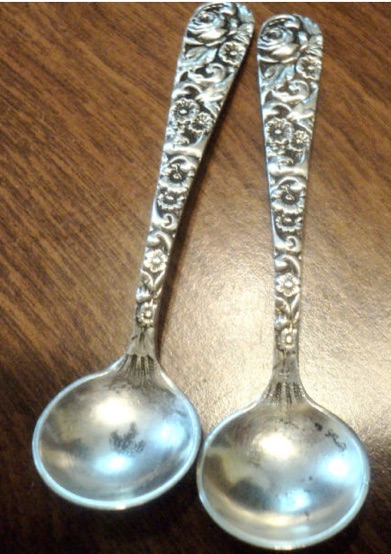
These do have a resemblance to Stieff Rose, a closer look reveals the differences. Certainly Baltimore patterns like this would have influenced the pattern design for Stieff Rose

A Jenkins and Jenkins knife handle
A. G. Schultz was a silver company in Baltimore 1899-1950

This Schultz pattern is also commonly mistaken for Schofield’s Baltimore Rose because of the two roses at the top of the pattern.
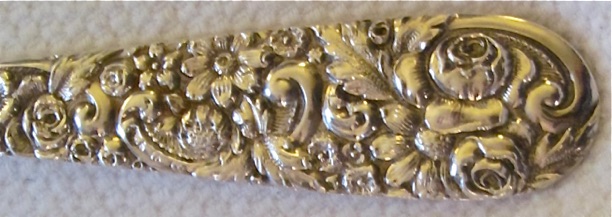
Schultz pieces have the mark of a hand with the word MADE inside
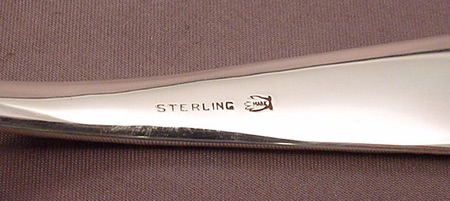
Manchester Silver
Southern Rose
1933 to 1973
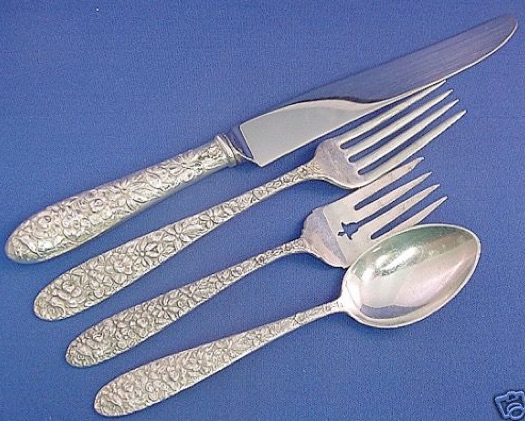


This seems to be the pattern that is most often mistaken for Stieff Rose by sellers on Ebay.
The Knife handles are not hand chased. There is not a center rose like on Stieff Rose, and the pattern is a lot thinner, less dense and the relief of the flowers is much lower.
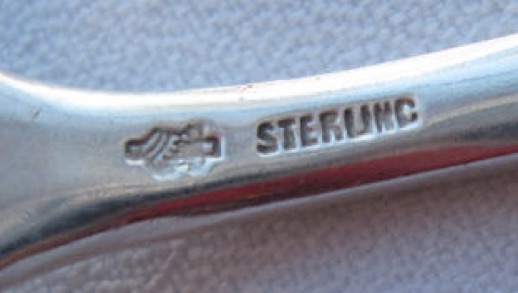
This is the hallmark on Manchester’s Southern Rose. It amazes me how many of these
knives end up on ebay as Stieff Rose despite the Manchester name on the blade.
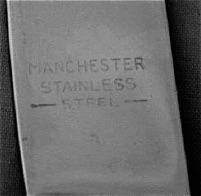
Knife blade of Manchester Southern Rose
A further confusion
Cale J. Schneider invented what is called a CAKE BREAK (or Breaker) in the early 1930s. A lot of companies bought the utensil part of the cake break from C. J. Schneider Mfg. Co of Toledo Ohio and put it on their silver handles. The utensil part is marked SCHNEIDER Toledo, which makes some people think that Schneider is the maker of the silver... but they were not. They only made the cake break part. These “cake breaks” are often found on brightly colored Lucite or Bakelite handles, but silver plated or sterling silver was fairly common too.
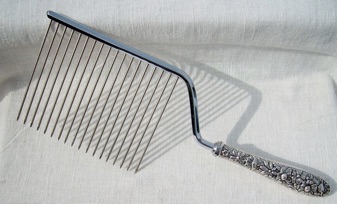
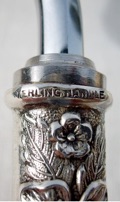

Shown above on a Manchester Southern Rose handle.
Radiant Rose 1938
International Silver Company

Radiant Rose as a hollow handle and below as a flat handle

Also of note is that the hollow handle is NOT chased on the sides like Stieff Rose would be.
G. H. FRENCH & Co.
North Attleboro MA 1920 -1939 Acquired by Ellmore Silver Co.
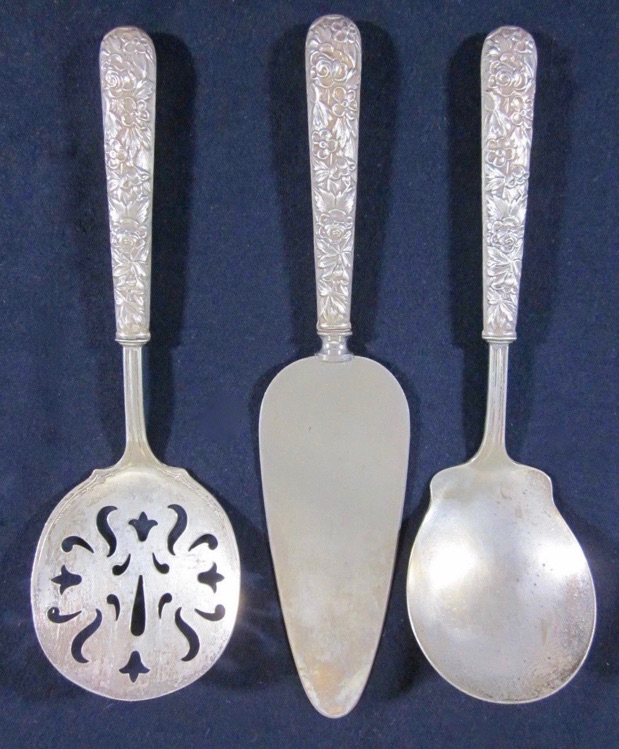
This ”Repoussé”pattern from G H French & Co. has open work on the side of the handle and the pattern does not envelope the entire handle. Very similar to the Southern Rose pattern of Manchester Silver Co. More often confused with the famous S. Kirk & Son pattern Repoussé.
